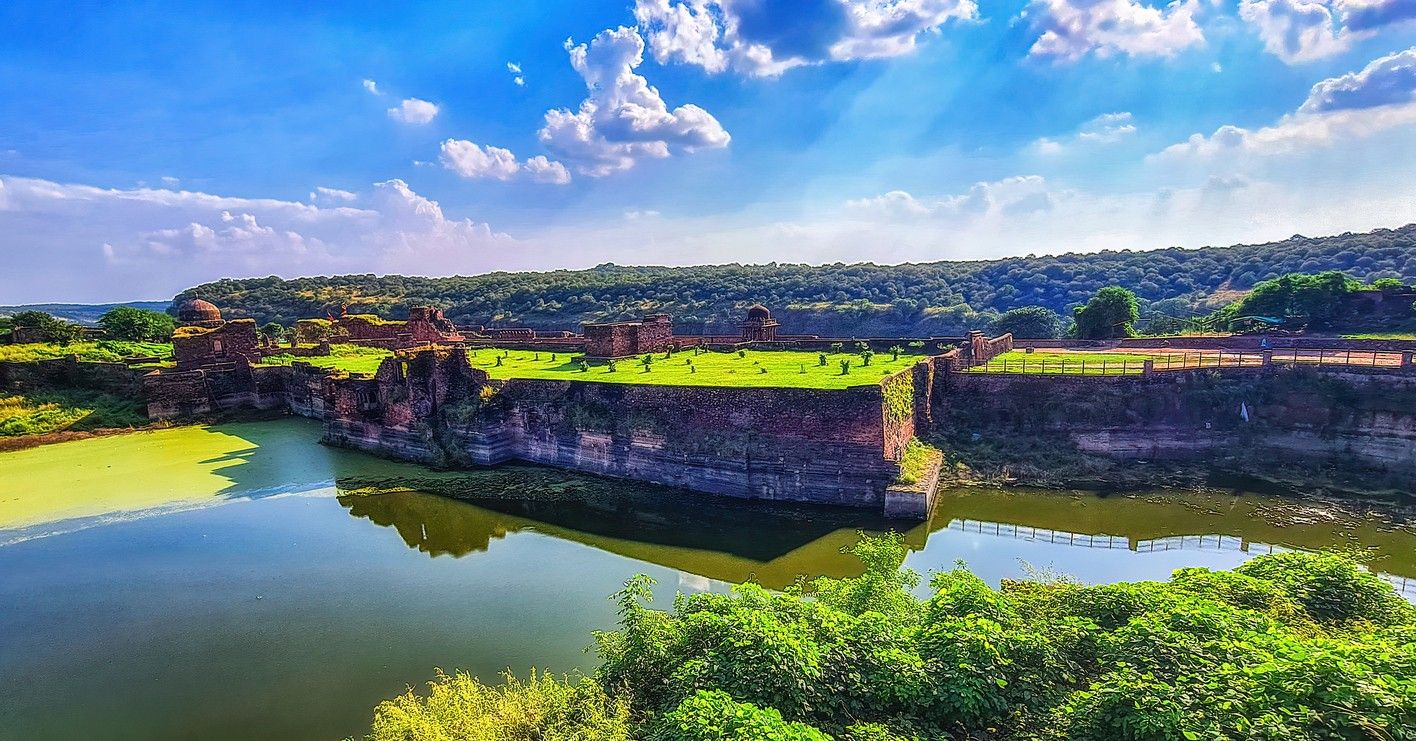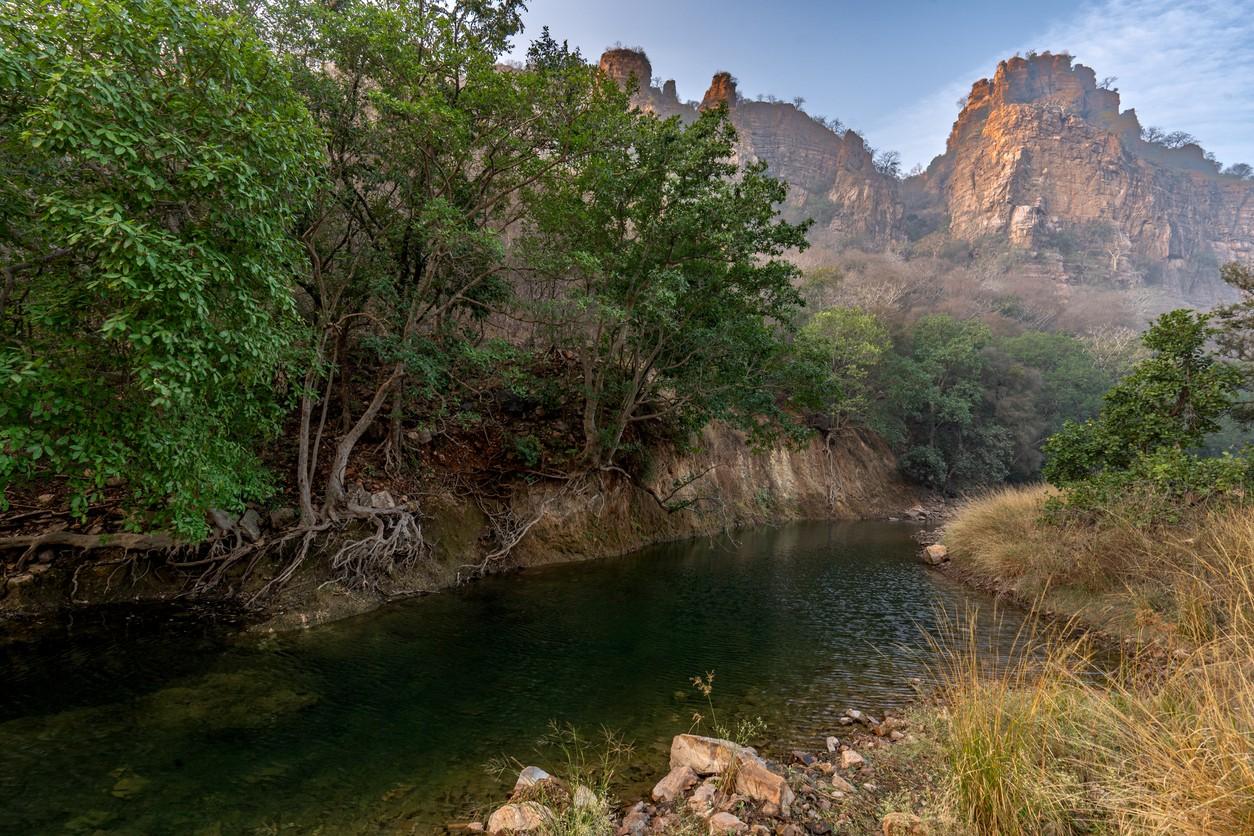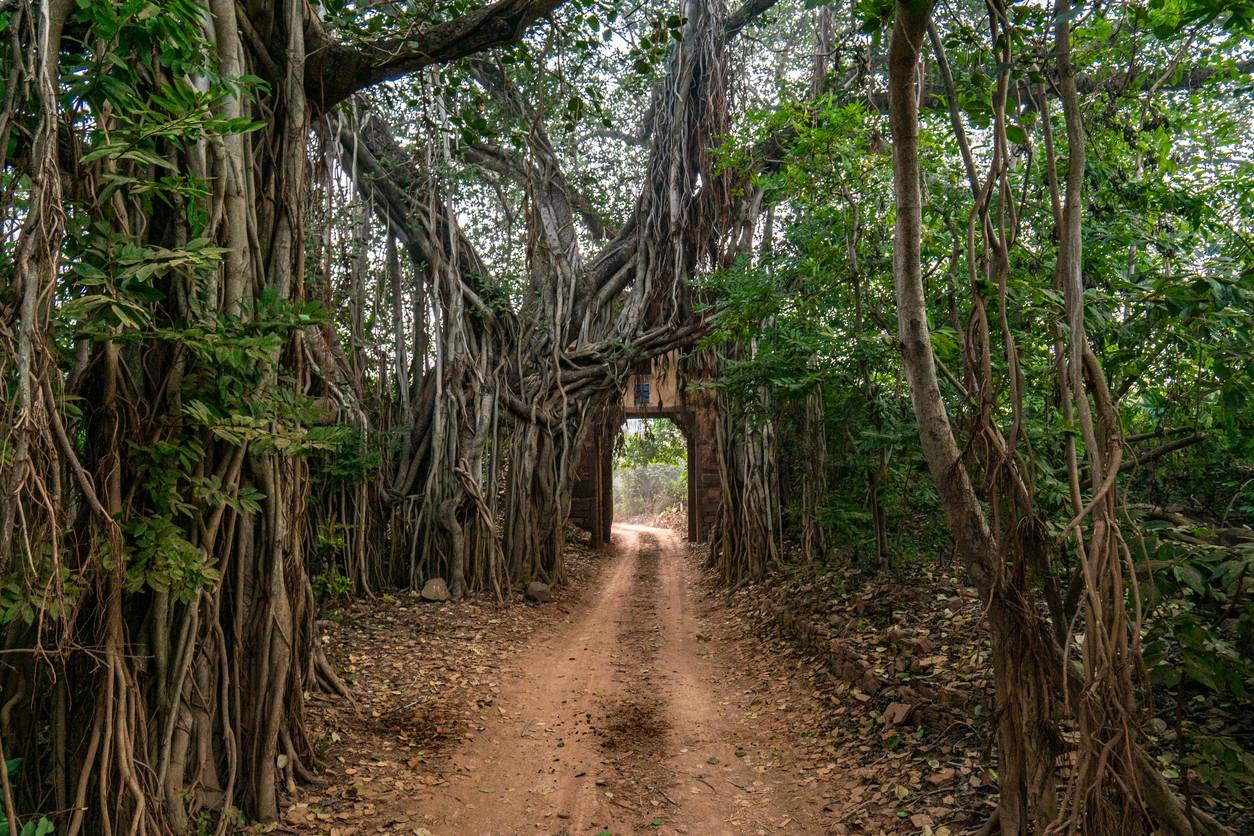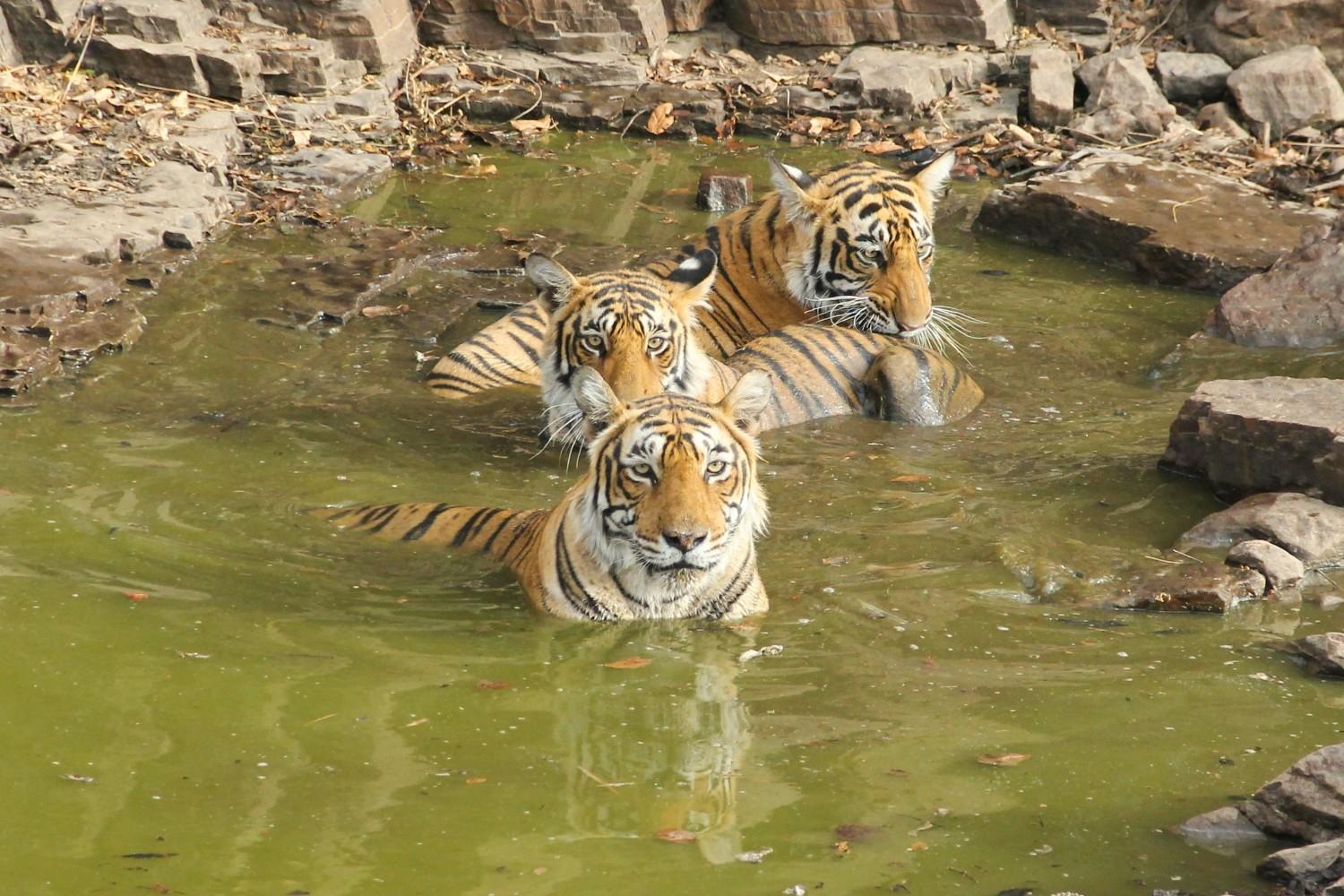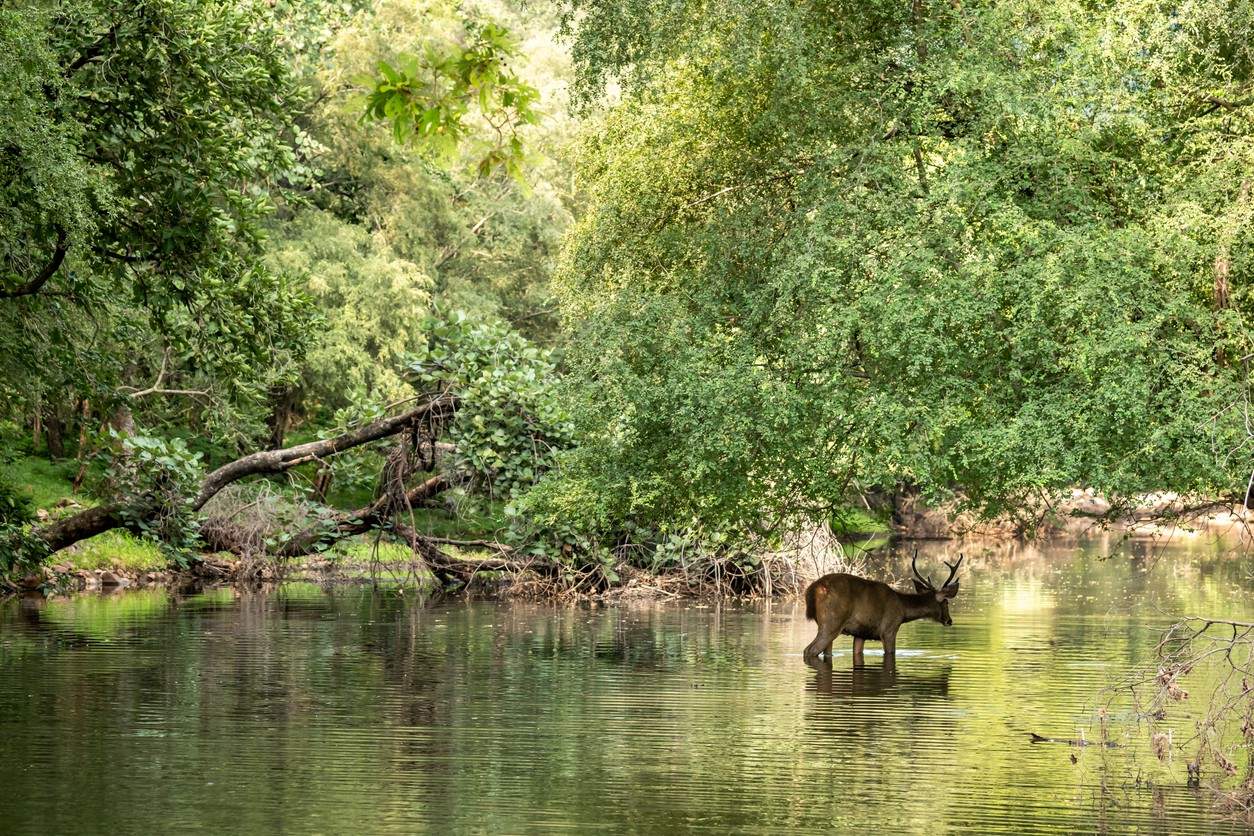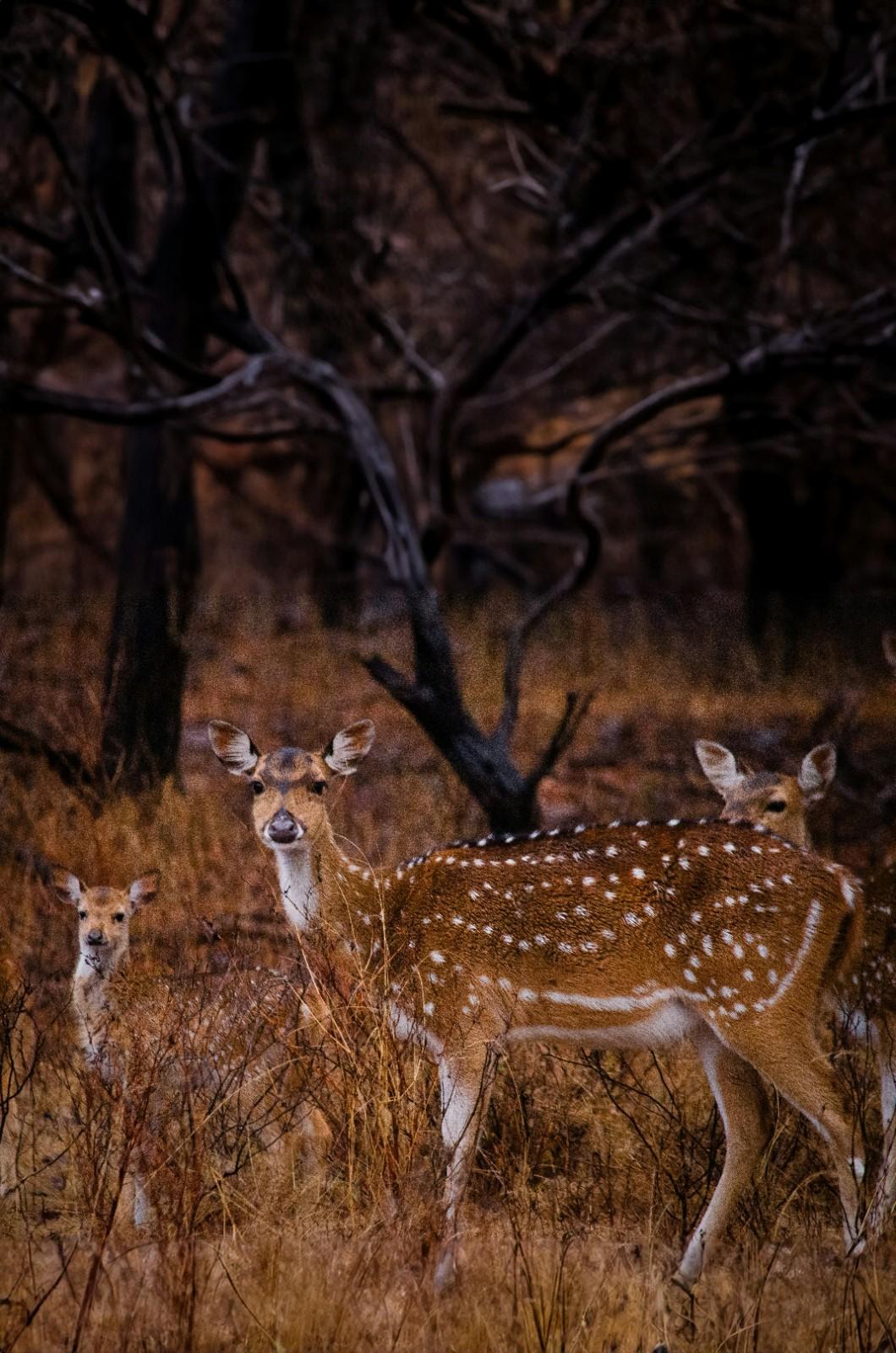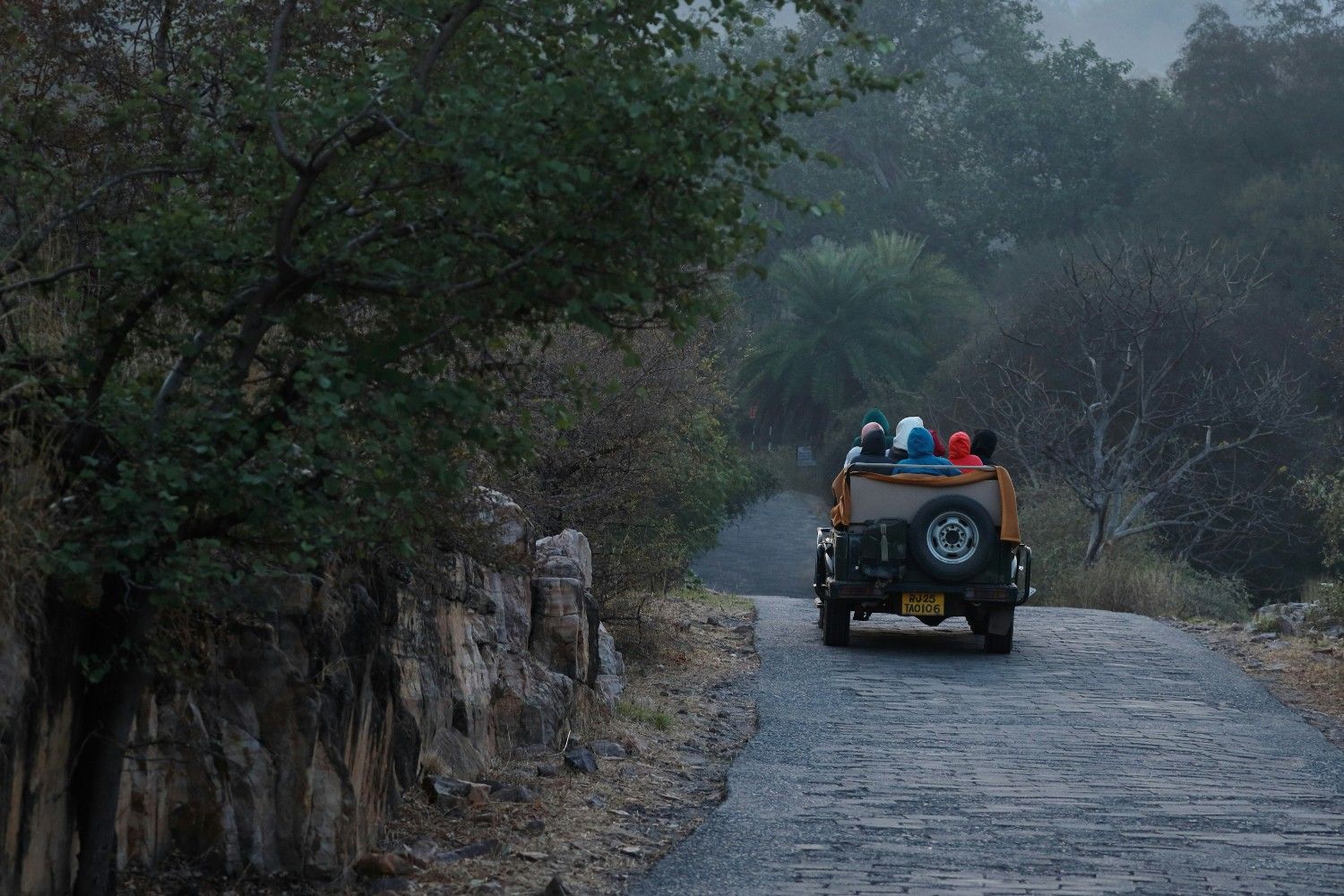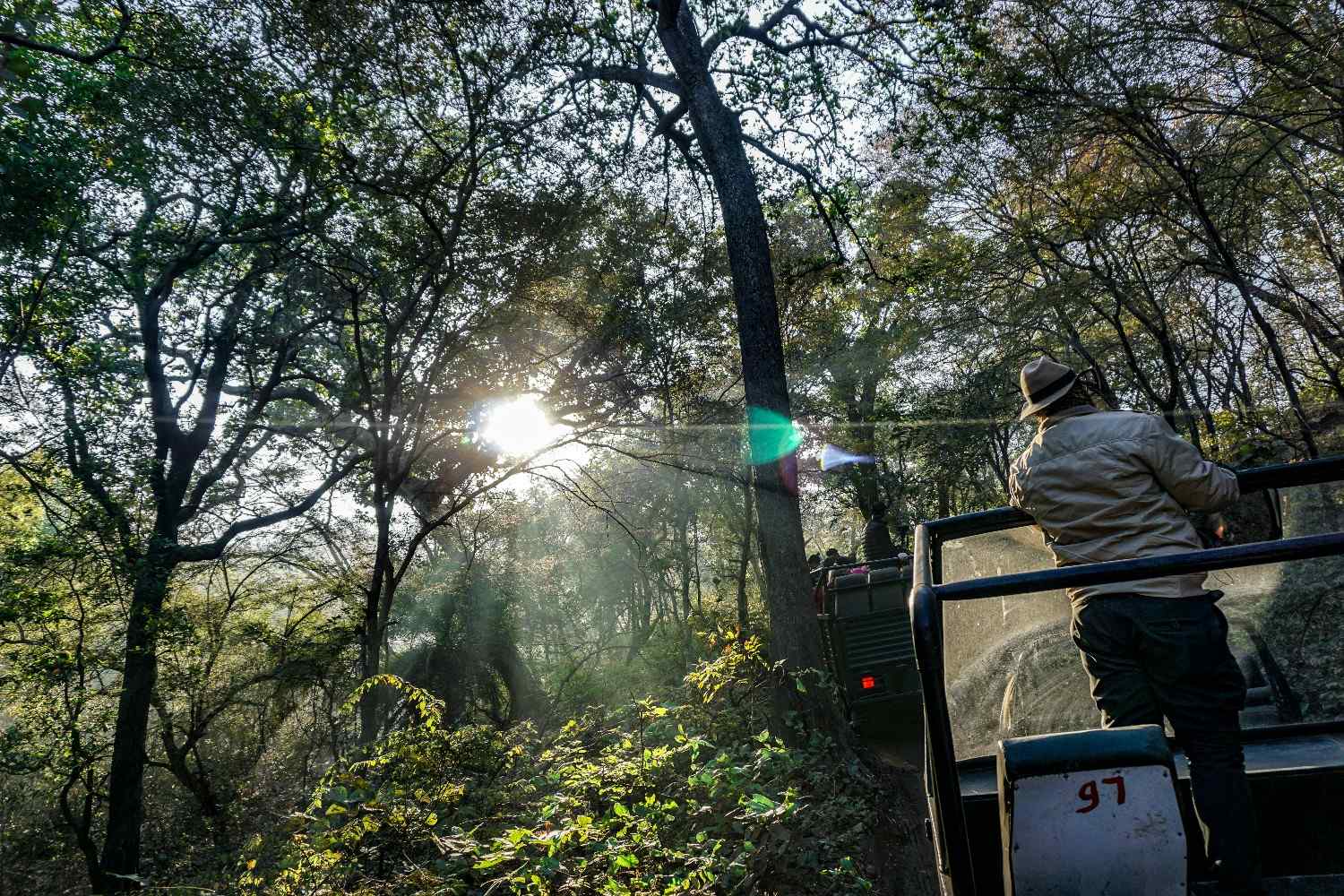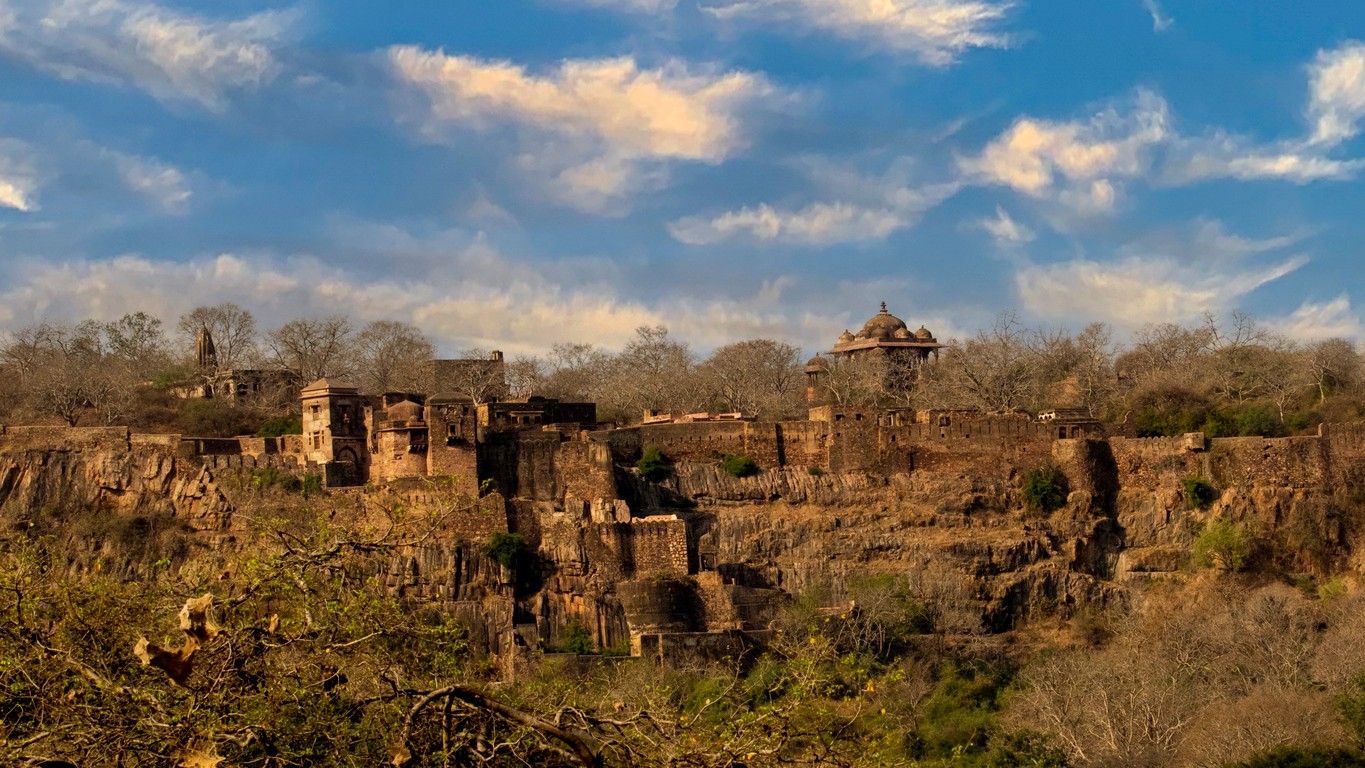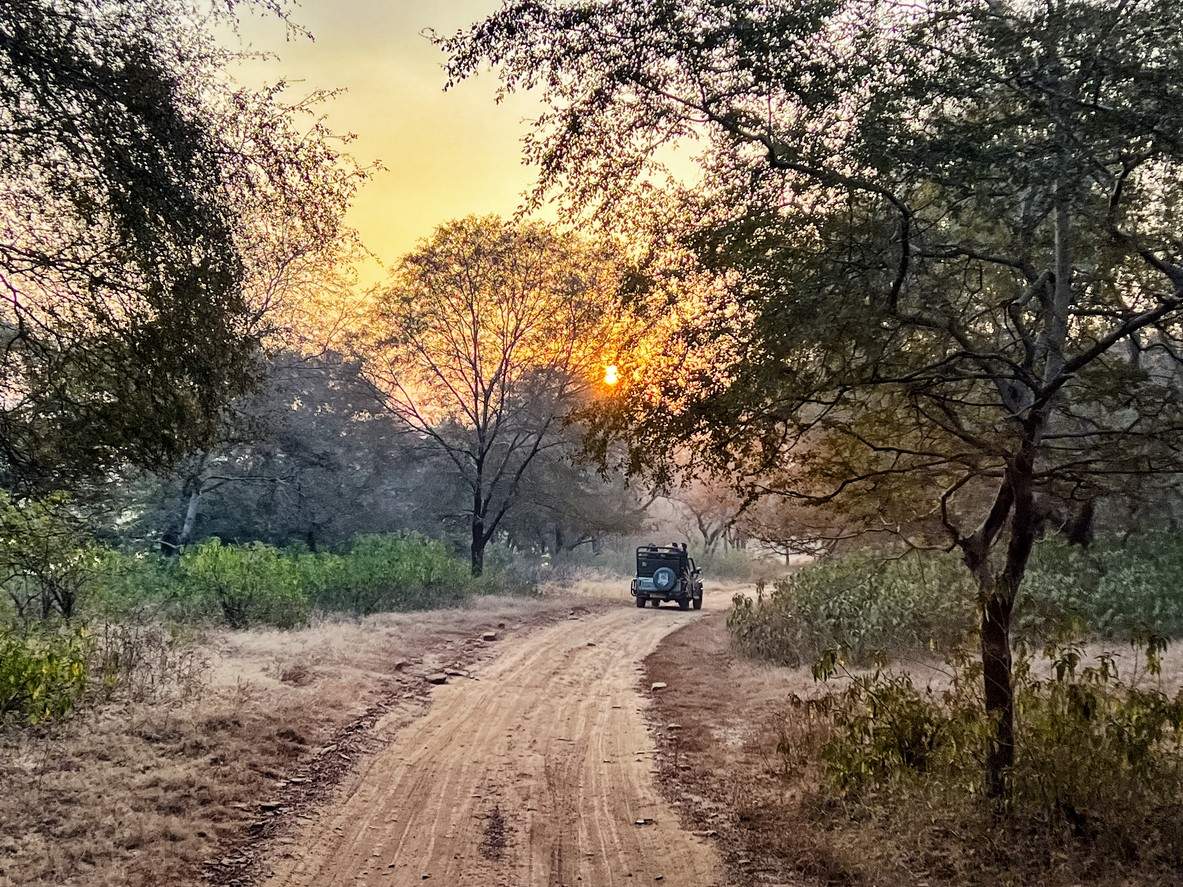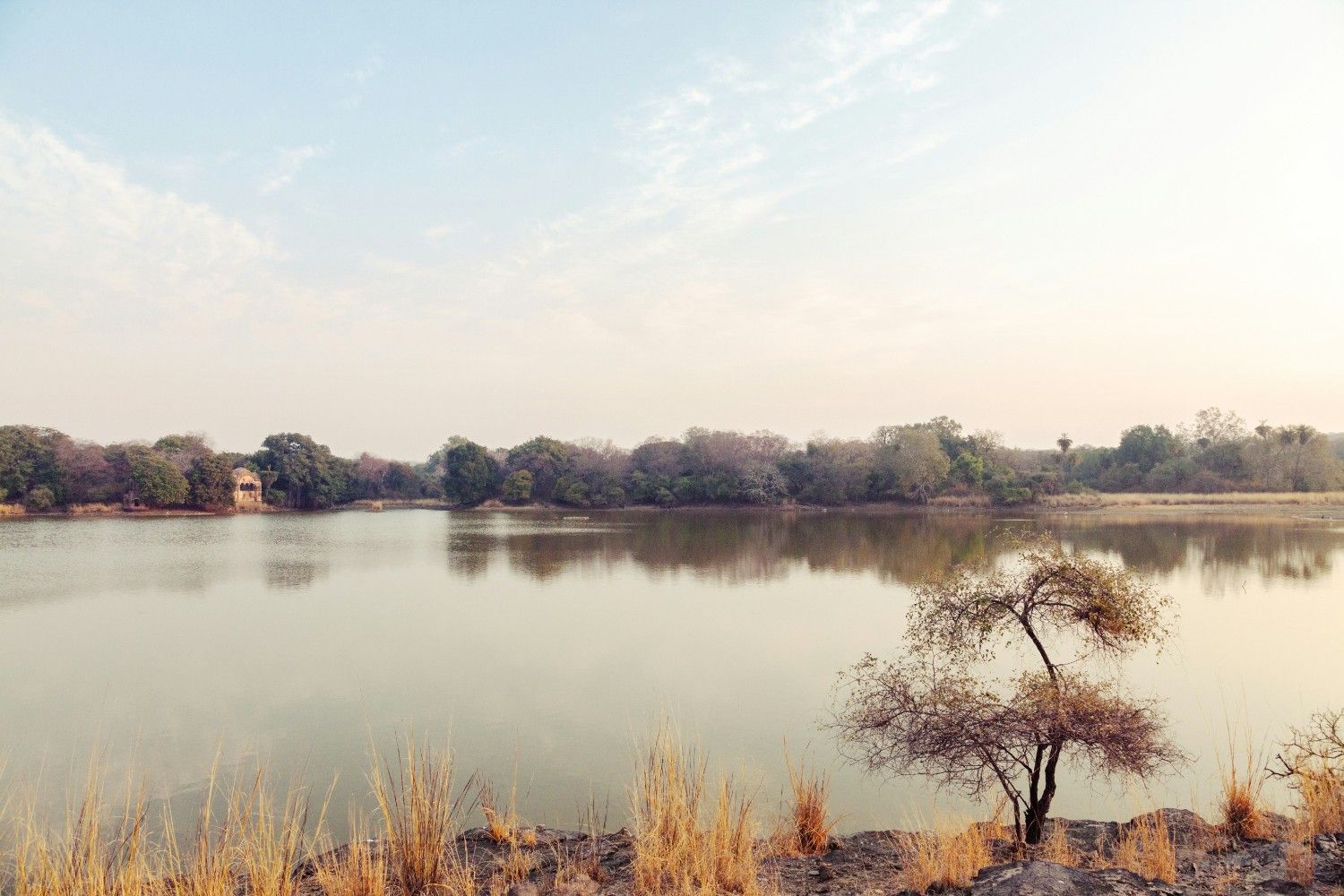Ranthambore National Park is located in the Sawai Madhopur district of Rajasthan, India. This vast expanse of wilderness, spanning an area of 392 square kilometres, is nestled amidst the ancient Aravalli and Vindhya hill ranges. The park's strategic location, combined with its rich natural heritage and historical significance, has made it a captivating destination for wildlife enthusiasts and history buffs alike.
The Origins and Historical Significance of Ranthambore
Ranthambore National Park is located in the Sawai Madhopur district of Rajasthan, India. This vast expanse of wilderness, spanning an area of 392 square kilometres, is nestled amidst the ancient Aravalli and Vindhya hill ranges. The park's strategic location, combined with its rich natural heritage and historical significance, has made it a captivating destination for wildlife enthusiasts and history buffs alike.
The Regal Legacy of Ranthambore Fort
At the heart of Ranthambore National Park stands the imposing Ranthambore Fort, a towering bastion that bears witness to the region's tumultuous and illustrious history. This formidable fortress, perched atop a hilltop at an elevation of 700 feet, dates back to the 8th century and was once the impregnable stronghold of the Chauhan dynasty. The fort's strategic location, nestled between two massive rocky ridges, and its impenetrable defences made it a coveted prize for successive rulers who sought to establish their dominance over this region. Its walls, constructed from massive blocks of red Karauli stone, stretch for a staggering three kilometres, enclosing within them a labyrinth of palaces, temples, and fortified gateways that speak volumes about the ingenuity and craftsmanship of its builders.
One of the fort's most striking features is the Ganesh Pol, a magnificent gateway adorned with intricate carvings and sculptures of Hindu deities, including the elephant-headed Lord Ganesha. This ornate entrance served not only as a means of access but also as a symbolic representation of the reverence and devotion that the ruling dynasties held for their spiritual beliefs. Within the fort's walls, visitors can explore the remnants of the Maharaja's Palace, a grand complex that once housed the opulent living quarters, audience halls, and administrative offices of the ruling elite. The palace's intricate frescoes, carved pillars, and ornate jharokhas (overhanging enclosed balconies) offer a glimpse into the lavish lifestyles and artistic sensibilities of the bygone era.
The Chauhan Dynasty's Legacy
The Chauhan dynasty, a formidable clan renowned for their military prowess and unwavering determination, left an indelible mark on Ranthambore's history. This dynasty, which ruled the region for centuries, played a pivotal role in shaping the fort's architecture and defences, transforming it into an impregnable citadel that could withstand the most formidable of sieges. The Chauhans were skilled architects and builders, and their influence can be seen in the intricate carvings, inscriptions, and architectural elements that adorn the fort's walls and structures. One of the most remarkable achievements of this dynasty was the construction of the Battis Khambha Chhatri, a magnificent cenotaph (memorial) carved from a single piece of rock, featuring 32 ornate pillars and exquisite carvings that depict scenes from Hindu mythology and the lives of the Chauhan rulers. The fort's numerous temples and shrines, such as the Ganesh Temple, the Ramlat Jharokha, and the Shiva Temple, also bear the architectural imprint of the Chauhans, reflecting their deep reverence for the Hindu faith and their desire to create spaces that celebrated their spiritual beliefs and cultural heritage..
The Mughal Conquest
In the 16th century, the formidable Mughal Empire set its sights on Ranthambore, and the fort became a battleground for control of the region. The Mughals, under the leadership of the legendary Emperor Akbar, laid siege to the fortress in 1559, determined to add this strategic outpost to their ever-expanding empire. The siege of Ranthambore Fort was a protracted and bloody affair, with the Chauhans, led by their valiant ruler Rao Surjan Hada, putting up a fierce and unyielding resistance against the Mughal onslaught. For nearly seven months, the fort's defenders, outnumbered and outgunned, held their ground, refusing to surrender to the invading forces. The Mughals, known for their military prowess and innovative tactics, employed a range of strategies to breach the fort's defences, including the use of gunpowder cannons and mining techniques to undermine the walls. Despite their relentless efforts, the Chauhans remained resolute, refusing to yield until the bitter end.
Finally, in 1569, after enduring a prolonged siege and facing the prospect of starvation, Rao Surjan Hada made the ultimate sacrifice, choosing to commit Jauhar (the ritualistic mass self-immolation of women and children) rather than surrender to the Mughals. This act of defiance and honour has been immortalised in the annals of Rajput history, cementing Ranthambore's legacy as a symbol of unwavering courage and resistance against foreign invasion. The fort's walls bear the scars of this epic conflict, with cannonball impact marks and remnants of the Mughal siege machinery serving as silent testaments to the sacrifices made by those who fought to defend their land and their way of life. The Mughal conquest of Ranthambore Fort not only marked a turning point in the region's political landscape but also left an indelible imprint on its architectural and cultural heritage.
A Sanctuary for Diverse Wildlife and Natural Wonders
While Ranthambore's historical legacy is undeniably captivating, it is the park's remarkable biodiversity that truly sets it apart. The dense forests, dotted with ancient banyan trees and dry deciduous vegetation, provide a haven for a wide array of flora and fauna, making it a true paradise for nature enthusiasts and wildlife lovers.
The Majestic Bengal Tiger: Ranthambore's Crown Jewel
Ranthambore National Park is renowned for its healthy population of Bengal tigers, the majestic apex predators that have become the iconic ambassadors of this natural wonderland. These magnificent creatures, with their powerful builds, striped coats, and piercing gazes, have captivated the hearts and imaginations of visitors from around the world. The park's dedicated conservation efforts have played a crucial role in ensuring the survival and protection of these remarkable animals. Through strict measures such as regular monitoring, anti-poaching patrols, and habitat management, Ranthambore has become a shining example of successful tiger conservation efforts in India.
One of the unique aspects of Ranthambore's tiger population is the degree of habituation among some individuals. While maintaining a respectful distance and adhering to strict guidelines, visitors may have the opportunity to observe these majestic creatures going about their daily routines, from hunting and marking their territories to resting and caring for their young. Witnessing a tiger in its natural habitat is a truly awe-inspiring experience, one that leaves a lasting impression on all who are fortunate enough to encounter these magnificent creatures. The sight of a tiger gracefully stalking its prey, its powerful muscles rippling beneath its striped coat, or a mother tenderly guiding her cubs is a reminder of the raw beauty and power of nature.
The Rocky Outcrops and Cliffs
The park's rugged terrain, characterised by towering cliffs and rocky outcrops, provides a unique habitat for species adapted to these harsh conditions. Here, visitors may catch a glimpse of the elusive leopard, blending seamlessly into the rocky crevices as it scans the landscape for prey. The nimble chinkara (Indian gazelle) can often be spotted navigating the steep slopes with remarkable agility, their slender legs carrying them effortlessly across the rugged terrain. These rocky areas are also home to a variety of reptiles, including the highly venomous Indian saw-scaled viper, which expertly camouflages itself among the rocks and crevices, waiting patiently for unsuspecting prey to pass by. Other reptilian inhabitants include the Indian rock python, which can often be seen basking in the warmth of the sun, and various species of lizards that scurry across the rocky outcrops in search of insects and other small prey.
The Serene Lakes and Waterholes
Dotting the landscape of Ranthambore National Park is a series of serene lakes and waterholes, which serve as vital sources of sustenance for the resident wildlife. These tranquil bodies of water not only provide drinking water but also support a thriving aquatic ecosystem, attracting a diverse array of species to their banks and shallows. Visitors may be treated to the sight of the formidable marsh crocodile basking in the sun, its powerful jaws agape as it warms itself on the sandy shores. Flocks of migratory birds, such as the majestic painted storks and graceful egrets, can often be seen wading through the shallow waters, their long legs and sharp beaks expertly navigating the aquatic environment in search of fish, frogs, and other aquatic prey.
The serene waters of these lakes and waterholes also provide a refuge for a variety of aquatic plants and algae, which in turn support a diverse array of microscopic organisms and aquatic invertebrates. This intricate web of life creates a vibrant ecosystem, underscoring the importance of these water sources for the overall health and sustainability of Ranthambore's wildlife. As the day draws to a close, the lakes and waterholes become a hub of activity, with animals of all sizes congregating to quench their thirst and bathe in the cool waters. It is not uncommon to witness majestic tigers or elusive leopards making their way to these water sources, providing visitors with a rare and unforgettable glimpse into the intricate dynamics of Ranthambore's natural world.
Exploring the Natural Wonders of Ranthambore
Ranthambore National Park offers visitors a plethora of opportunities to immerse themselves in its natural splendour and witness the wonders of its diverse ecosystems firsthand. From guided safaris to scenic walking trails and boat excursions, the park caters to a variety of interests and adventure levels.
Safaris — Embarking on an Unforgettable Wildlife Encounter
One of the most popular and exhilarating ways to explore Ranthambore is by embarking on a safari. Visitors can choose between two modes of transportation: jeep safaris and elephant-back safaris, each offering a unique and unforgettable experience.
Jeep Safaris — Jeep safaris are the most common and accessible way to venture into the park's depths. These guided tours, led by experienced naturalists, provide an up-close and personal encounter with the park's inhabitants. As the jeep navigates the winding trails, visitors have the opportunity to witness the tigers, leopards, and other wildlife in their natural habitat, observing their behaviours and interactions with a sense of wonder and respect.
Elephant-Back Safaris — For those seeking a more immersive and distinctive experience, elephant-back safaris offer a truly unique perspective on Ranthambore's wilderness. Riding atop these majestic creatures, visitors can silently traverse the park's terrain, blending seamlessly into the surroundings and getting closer to the wildlife than ever before. The gentle swaying of the elephant's gait and the rustling of leaves create an unparalleled sense of connection with nature, making this an unforgettable adventure.
Scenic Walking Trails
Ranthambore National Park offers a network of scenic walking trails that wind through the forests, providing visitors with a more leisurely and intimate way to explore the park's natural wonders. These guided walks, led by experienced naturalists, offer opportunities to spot birds, butterflies, and other smaller creatures that might be overlooked during a jeep or elephant safari. The trails vary in length and difficulty, catering to visitors of all fitness levels.
Ranthambore Fort Trail — This popular trail takes visitors on a journey through the park's rich history and natural beauty. Starting from the park's entrance, the trail winds its way to the iconic Ranthambore Fort, offering stunning views of the surrounding landscapes and wildlife along the way. The trail is approximately 5 kilometres long and is considered moderately challenging due to the uneven terrain.
Padam Talao Trail — Immerse yourself in the serene beauty of Ranthambore's wetlands on the Padam Talao Trail. This 3-kilometer trail leads visitors to the picturesque Padam Talao, a tranquil lake where migratory birds and other aquatic species can be observed in their natural habitat.
Lakarda Trail — For those seeking a more challenging experience, the Lakarda Trail is a must-visit. Stretching over 10 kilometres, this trail takes hikers through the park's rugged terrain, offering
glimpses of the majestic tigers, leopards, and other wildlife that call this area home.
Bamboo Trail— As the name suggests, the Bamboo Trail winds through lush bamboo groves, providing a unique and serene walking experience. This 2-kilometre trail is ideal for those seeking a more leisurely pace and offers opportunities to spot various bird species and smaller mammals.
Rajbagh Trail — The Rajbagh Trail is a 6-kilometer loop that takes visitors through the park's diverse ecosystems, including open grasslands, dense forests, and rocky outcrops. Along the way, hikers may encounter sambar deer, nilgai, and various bird species.
Arna Trail — For birdwatchers and nature enthusiasts, the Arna Trail is a must-visit. This 4-kilometre trail traverses through the park's lush greenery, offering excellent opportunities to spot a wide variety of avian species, including the vibrant Indian peafowl and the majestic crested serpent eagle.
Kachida Valley Trail — Explore the park's hidden gems on the Kachida Valley Trail. This 8-kilometre trail takes visitors through a picturesque valley, offering stunning views of the surrounding landscapes and the chance to spot elusive wildlife such as leopards and sloth bears.
Boat Safaris
For those seeking a unique perspective on Ranthambore's aquatic life and avian species, boat safaris along the park's serene lakes and reservoirs offer a tranquil and peaceful experience. As the boat glides across the water's surface, visitors can observe a variety of bird species, such as the majestic painted storks, graceful egrets, and vibrant kingfishers, as they go about their daily routines. These boat tours also provide an opportunity to spot crocodiles basking on the banks, as well as other aquatic creatures that call these wetlands home. The gentle lapping of the water and the peaceful atmosphere make these excursions a welcome respite from the hustle and bustle of daily life, allowing visitors to truly connect with the park's natural rhythms.
Accommodation and Amenities for a Memorable Stay
Ranthambore National Park offers a range of accommodation options to suit various preferences and budgets, ensuring that visitors can find the perfect base to experience the park's natural wonders and explore its rich cultural heritage.
Luxurious Resorts and Heritage Hotels
Ranthambore boasts a collection of world-class resorts and heritage hotels. These stunning properties, often housed in renovated palaces or historic buildings, offer a seamless blend of modern amenities and traditional charm.
Nahargarh Ranthambhore — Located just a stone's throw away from the park's entrance, this regal property was once the hunting lodge of the Maharaja of Jaipur and now offers guests an unforgettable experience steeped in opulence and grandeur.
Aman-i-Khas — Nestled in the heart of the wilderness, this luxurious tented camp offers a truly immersive and sustainable experience, combining the comforts of modern luxury with the authentic charm of a traditional safari camp.
Oberoi Vanyavilas — Consistently ranked among the best luxury resorts in the world, the Oberoi Vanyavilas is a haven of tranquility and indulgence, with exquisitely appointed accommodations, world-class dining, and unparalleled service.
Sher Bagh — This award-winning heritage hotel, located near the park's Khilchipur gate, combines the elegance of a bygone era with contemporary comforts, offering guests a truly regal experience in the heart of Ranthambore.
Sawai Vilas — Formerly the royal hunting lodge of the Maharaja of Jaipur, this palatial property has been meticulously restored and now offers guests a glimpse into the opulent lifestyles of the Rajput royalty.
Rustic Jungle Camps and Forest Rest Houses
Ranthambore's jungle camps and forest rest houses offer a unique opportunity to reconnect with nature. These eco-friendly accommodations are nestled deep within the park's forests, providing visitors with a truly rustic and sustainable lodging experience.
Ranthambare Tiger Resort — This eco-friendly jungle camp offers a unique blend of comfort and sustainability, with luxurious tents equipped with modern amenities while remaining true to the essence of a safari camp experience.
Canter Camping — Embrace the true spirit of adventure with Canter Camping, where guests can experience the thrill of camping in the heart of the wilderness, surrounded by the sights and sounds of Ranthambore's diverse wildlife.
Khem Vilas — Located within the park's boundaries, Khem Vilas is a charming forest rest house that offers guests a peaceful and serene retreat, with comfortable accommodations and easy access to the park's trails and wildlife viewing areas.
Machiya Village Huts — For a truly immersive cultural experience, consider staying at the Machiya Village Huts, where guests can experience the traditional way of life of the local communities while enjoying the comforts of modern amenities.
Mid-Range Hotels and Guesthouses
Ranthambore offers a variety of mid-range hotels and guesthouses. These accommodations cater to a wide range of budgets and preferences, providing clean and comfortable rooms, basic amenities, and often a restaurant or dining area.
Tiger Den Resort — Conveniently located near the park's entrance, Tiger Den Resort offers comfortable accommodations, a multi-cuisine restaurant, and a range of amenities to ensure a pleasant stay.
Tiger Tops Cottage — This charming guesthouse, situated in the heart of the village, provides guests with a warm and welcoming atmosphere, along with easy access to local markets and attractions.
Ranthambhore Regency — With its well-appointed rooms, outdoor pool, and on-site restaurant, Ranthambhore Regency offers a comfortable and convenient base for exploring the park and its surroundings.
Vinayak Resort — Nestled amidst lush greenery, Vinayak Resort is a hidden gem that offers a peaceful and serene retreat, with comfortable accommodations and a range of basic amenities to meet the needs of budget-conscious travellers.
Hotel Tiger Tops — Offering a perfect blend of comfort and affordability, Hotel Tiger Tops is a popular choice among visitors, with its clean and well-maintained rooms, friendly staff, and convenient location near the park's entrance.
Regardless of the accommodation choice, visitors to Ranthambore National Park can expect to find a range of amenities and services tailored to enhance their overall experience. From on-site restaurants serving local and international cuisine to recreational facilities such as swimming pools and spas, the park's accommodations strive to ensure that guests have a comfortable and memorable stay while exploring the natural wonders and cultural heritage of this extraordinary destination.
Planning Your Visit to Ranthambore National Park
To fully appreciate the natural and historical wonders of Ranthambore National Park, meticulous planning is essential. The park operates on a seasonal schedule, and visitors should carefully consider the best times to visit, as well as make necessary arrangements for accommodation and safari permits well in advance.
The Best Time to Visit Ranthambore — Ranthambore National Park is open throughout the year, but the dry months between October and June are considered the best times to visit. During this period, the vegetation is less dense, and the chances of spotting wildlife are higher as animals congregate around the park's waterholes and water holes in search of sustenance.
The Park's Seasonal Schedule — The park is typically closed during the monsoon season, from July to September, as the heavy rains can make the terrain difficult to navigate and potentially disrupt the natural habitats of the resident wildlife. However, the park's lush greenery and occasional showers during this period can offer a different perspective and unique experiences for intrepid visitors willing to brave the elements.
October to March: The Peak Season — The peak season for Ranthambore National Park falls between October and March, when the weather is mild and dry, making it the ideal time for wildlife viewing. During this period, the park sees an influx of visitors from around the world, eager to witness the majestic tigers and other resident species in their natural habitats.
April to June: The Hot and Dry Season — As the summer months approach, from April to June, the park experiences increasingly hot and dry conditions. While the temperatures can be challenging, this period can be an excellent time for wildlife enthusiasts as the scarce water sources draw animals to the park's waterholes and lakes, providing ample opportunities for sightings.
Advance Bookings and Planning — To ensure a seamless and rewarding experience at Ranthambore National Park, it is crucial to book accommodations and safari permits well in advance. The park's popularity means that availability can be limited, especially during peak seasons, and securing reservations early is highly recommended. Visitors should also be prepared for the region's warm and dry climate, packing appropriate clothing, sunscreen, and hydration essentials. Additionally, it is advisable to consult with local tour operators or travel agencies to obtain the most up-to-date information on park regulations, safari timings, and any special events or activities that may be taking place during the planned visit.
Related articles

Let us know you agree to cookies
We use marketing, analytical and functional cookies as well as similar technologies to give you the best experience. Third parties, including social media platforms, often place tracking cookies on our site to show you personalised adverts outside of our website.
We store your cookie preferences for two years and you can edit your preferences via ‘manage cookies’ or through the cookie policy at the bottom of every page. For more information, please see our cookie policy.
